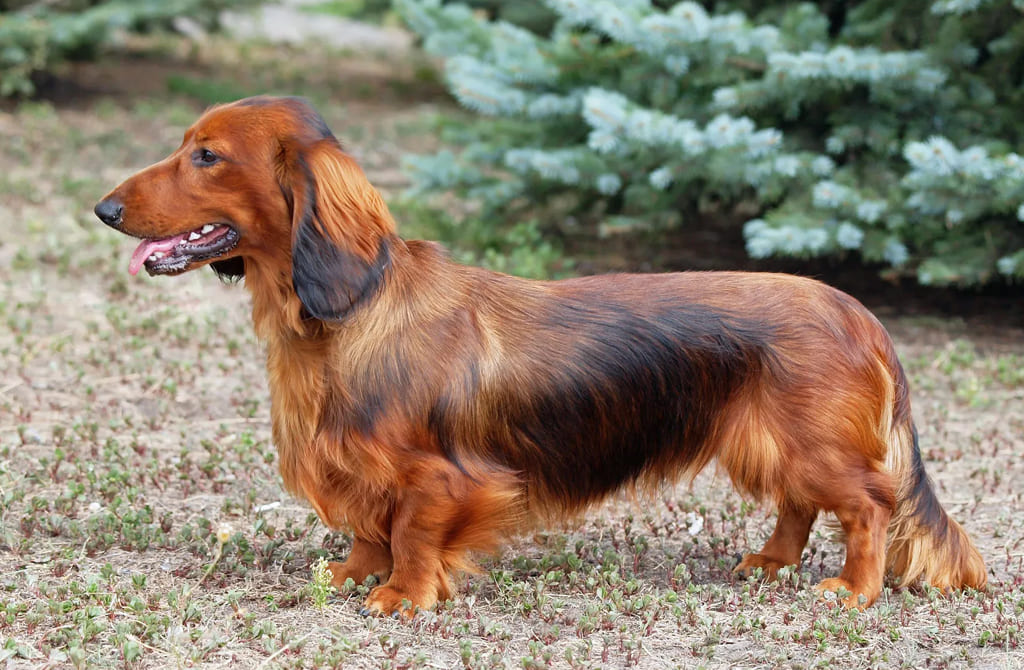Explore the history and traits of Dachshunds, the long-bodied canine companions known for their bold personalities, rich hunting heritage, and unique appearance. 0 0 0
Dachshunds: History and Traits of the Long-bodied Canine Companion
Introduction:
Dachshunds, affectionately known as “wiener dogs” due to their elongated bodies, are one of the most recognizable and beloved dog breeds in the world. With their distinctive shape, spirited personality, and rich history, Dachshunds have become a favorite among dog enthusiasts. This article delves into the fascinating history of Dachshunds and explores the unique traits that make them exceptional companions.
The Origins of the Dachshund
The Dachshund’s history dates back to 15th-century Germany, where they were originally bred for hunting purposes. The name “Dachshund” itself translates to “badger dog” in German, reflecting their primary role in hunting and flushing out badgers from their burrows. Early Dachshunds were larger than today’s standard, with a strong, elongated body, short legs, and an exceptional sense of smell—traits that made them perfect for following scent trails and maneuvering through tight underground spaces.
Over time, Dachshunds were bred in two sizes: standard and miniature. The standard size was primarily used for hunting larger prey like badgers and wild boar, while the miniature Dachshunds were developed for hunting smaller game such as rabbits. This adaptability in size and function made the Dachshund a versatile hunting companion.
Dachshund Traits and Characteristics
Dachshunds are small yet sturdy dogs, characterized by their long bodies, short legs, and elongated snouts. They come in three coat varieties: smooth, longhaired, and wirehaired, each with its own distinct texture and grooming needs. Despite their size, Dachshunds possess a bold and fearless demeanor, often described as “big dogs in small bodies.”
Personality and Temperament
Dachshunds are known for their lively and curious nature. They are intelligent, independent thinkers, which can sometimes translate to a stubborn streak. However, this same intelligence makes them quick learners, especially when motivated by positive reinforcement and treats. Dachshunds are loyal and protective of their families, often forming strong bonds with their owners. Their playful and affectionate nature makes them excellent companions, but they can also be wary of strangers, making them good watchdogs.
Exercise and Care
While Dachshunds are small dogs, they require regular exercise to keep them healthy and prevent obesity—a common issue for this breed due to their unique body shape. Daily walks and playtime are essential to meet their energy needs. Given their hunting background, Dachshunds may also enjoy activities that engage their keen sense of smell, such as scent work or tracking games.
They are prone to certain health issues, particularly those related to their long spine. Intervertebral Disc Disease (IVDD) is a common condition in Dachshunds, so it’s crucial to avoid activities that put unnecessary strain on their back, such as jumping from heights. Providing proper support when lifting or carrying a Dachshund and maintaining a healthy weight are important preventive measures.
The Dachshund’s Place in Modern Society
Today, They are more commonly found as loving companions than as hunting dogs, but their hunting instincts remain intact. They excel in various dog sports, including Earthdog trials, where they can showcase their natural digging and burrowing abilities. Dachshunds are also popular in agility competitions, where their determination and agility shine.
The breed’s popularity has only grown over the years, with Dachshunds being a favorite in popular culture, from cartoons to movies. Their unique appearance and lively personality have made them a staple in many households worldwide.
Conclusion
They are more than just a breed with an amusing appearance—they are a testament to the enduring bond between humans and dogs, bred for a purpose yet adaptable as loving companions. Whether you are drawn to their quirky looks, spirited personalities, or rich history, Dachshunds continue to win the hearts of dog lovers everywhere. Their legacy as a courageous, loyal, and affectionate breed ensures they will remain beloved companions for generations to come. 0 0 0
You Might Like:
Dachshunds: Frequently Asked Questions (FAQs)
1. What were Dachshunds originally bred for?
Dachshunds were originally bred in Germany for hunting badgers and other burrowing animals, thanks to their long bodies and strong sense of smell.
2. What are the different types of Dachshunds?
Dachshunds come in two sizes: standard and miniature. They also have three coat varieties: smooth, longhaired, and wirehaired.
3. Are Dachshunds good family pets?
Yes, Dachshunds are known for being loyal, affectionate, and protective, making them great family pets. However, their independent nature means they can sometimes be stubborn.
4. What health issues are common in Dachshunds?
They are prone to Intervertebral Disc Disease (IVDD) due to their long spine, as well as obesity if not properly exercised and fed.
5. How much exercise do Dachshunds need?
They need regular exercise, including daily walks and playtime, to stay healthy and prevent obesity. Activities that engage their sense of smell, like scent work, are also beneficial.
6. Are Dachshunds easy to train?
They are intelligent and can be trained effectively with patience and positive reinforcement. However, their stubborn streak may require consistent training.
7. Do Dachshunds get along with other pets?
They can get along well with other pets, especially if socialized early, but their hunting instincts may cause them to chase smaller animals.
8. How do I care for a Dachshund’s back?
To protect a Dachshund’s back, avoid letting them jump from heights, support their spine when lifting them, and maintain a healthy weight to reduce strain.
9. How long do Dachshunds typically live?
They have a relatively long lifespan, typically ranging from 12 to 16 years with proper care.
10. What makes Dachshunds unique compared to other breeds?
Dachshunds are unique due to their long-bodied, short-legged appearance, their origins as badger hunters, and their combination of intelligence, independence, and loyalty. 0 0 0
Main Facts About Dachshunds
- Origin: They originated in 15th-century Germany, bred primarily for hunting badgers and other burrowing animals.
- Name: The name “Dachshund” translates to “badger dog” in German.
- Sizes and Varieties: It come in two sizes—standard and miniature—and three coat types: smooth, longhaired, and wirehaired.
- Personality: Known for their bold, lively, and intelligent nature, Dachshunds are affectionate but can be stubborn and independent.
- Health Concerns: Due to their long spine, Dachshunds are prone to Intervertebral Disc Disease (IVDD), requiring careful management of their weight and activities.
- Exercise Needs: Despite their small size, They need regular exercise and mental stimulation, enjoying activities like scent work and agility.
- Cultural Impact: They have become iconic in popular culture, known for their unique appearance and loyal companionship. 0 0 0










